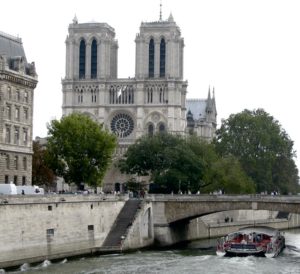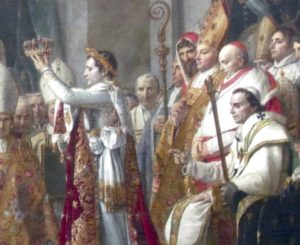
This past December, headlines screamed “First Christmas Without Mass in Notre Dame Cathedral in Two Hundred Years.” What happened two hundred years ago both to interrupt and to reinstate that structure’s sacred use? The French Revolution and Napoleon Bonaparte.
Tragically, the photo above explains why there wasn’t a mass in 2019. On April 15, the iconic cathedral burned in a devastating fire that still  threatens its collapse. That day I cried, mesmerized as the disaster unfolded on my television. I first saw Notre Dame when I was eleven years old. Then its limestone was black from pollution. When I last saw it, its newly cleaned façade sparkled. I loved its majesty in either of those guises. Naively, I’d thought of it as an indestructible constant in human culture.
threatens its collapse. That day I cried, mesmerized as the disaster unfolded on my television. I first saw Notre Dame when I was eleven years old. Then its limestone was black from pollution. When I last saw it, its newly cleaned façade sparkled. I loved its majesty in either of those guises. Naively, I’d thought of it as an indestructible constant in human culture.
Perhaps that was how French priests felt in 1789. They, too, were wrong.
Notre Dame and the French Revolution
The French Revolution was famously anti-aristocrat. It was equally anti-clerical, stripping the Catholic Church of wealth and murdering priests. The Revolutionary government plundered Notre Dame, claimed it as public property, and rededicated it to the Cult of Reason. The grand interior with its gothic vaults became a warehouse. As the Terror reigned in Paris, Notre Dame’s statues of saints—mistaken for kings—were beheaded.
By November 1799, the French Revolution had exhausted its bloody course. France, bankrupt and at risk of invasion, discovered a new idol—thirty-year-old General Napoleon Bonaparte.
Napoleon Takes Charge
Napoleon Bonaparte, although raised Catholic in superstitious Corsica, was skeptical of religion. But he wasn’t an atheist. Andrew Robert’s Napoleon, A Life, quotes one of his typical remarks: “One should render unto God that which is God’s…but the Pope is not God.”
Like many cynical leaders, Napoleon Bonaparte viewed religion as a tool to keep the masses in check. Betsy Balcombe’s memoir of the Emperor’s exile on St Helena relates his practical approach as a conqueror when Napoleon tells her, “I always adopt the religion of the country I am in.”
Napoleon’s Concordat with the Church
 After the chaos of the French Revolution, First Consul Napoleon Bonaparte turned to the moral power of religion to restore civil order. Napoleon’s military victories in Italy gave him leverage over the Papal States and their new pope, Pius VII. From that strength, Napoleon negotiated the Concordat of 1801, the post-Revolution reconciliation between the Catholic Church and the French state (shown above in dramatic allegory).
After the chaos of the French Revolution, First Consul Napoleon Bonaparte turned to the moral power of religion to restore civil order. Napoleon’s military victories in Italy gave him leverage over the Papal States and their new pope, Pius VII. From that strength, Napoleon negotiated the Concordat of 1801, the post-Revolution reconciliation between the Catholic Church and the French state (shown above in dramatic allegory).
While this agreement reestablished the right of the Catholic Church to exist in France, it neither gave back its seized property nor recognized its dominance over the state. The French people returned to the soul-saving sacraments. The Pope got a foothold in France again, but a weak one. The French government named the bishops and managed the Church’s finances. Religion helped reinstate societal norms, upset during the Revolution’s chaos. Napoleon gained support from France’s largely Catholic populace.
On Easter Sunday, April 18, 1802, the Concordat was announced in Notre Dame Cathedral. That year, Christmas Mass was once again celebrated on its altar, as it would be every year until 2019.
 To this day, Notre Dame Cathedral itself reflects the terms of Napoleon’s Concordat: the property belongs to the State which maintains it. The Catholic Church holds a lease, albeit into perpetuity.
To this day, Notre Dame Cathedral itself reflects the terms of Napoleon’s Concordat: the property belongs to the State which maintains it. The Catholic Church holds a lease, albeit into perpetuity.
Napoleon Bonaparte, one of history’s great propagandists, made full use of the pageantry of the Church. On December 2, 1804, Notre Dame was the setting for his coronation as emperor. Pope Pius VII, his reluctant guest, bestowed the Church’s blessing upon the Bonaparte dynasty.
